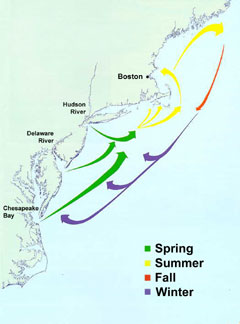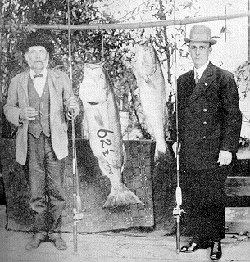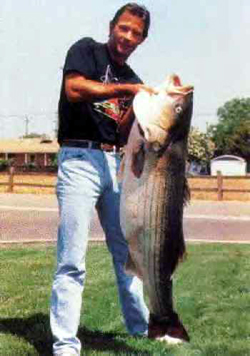The Elusive Striped Bass
Striped bass, or “stripers,” are among the most sought after fish by bass anglers. Striped bass breed in fresh water, but spend their adult lives in salt water. They are also able to live exclusively in fresh water in some inland water bodies. Four important areas with breeding stocks of striped bass are Chesapeake Bay, Cape Cod, the Hudson River and the Delaware river. All these areas are popular for bass fishing, especially the Chesapeake, which is one of the largest breeding areas. Striped bass have been introduced by state game and fish commissions into many reservoirs to the delight of anglers. These choice fish have also been hybridized with other kinds of bass to produce specialized sport fish such as the sunshine bass and paradise bass.
Striped bass can be finicky about what baits they will take. Many baits are used in bass fishing for stripers, including clams, eels, small fish, night crawlers, chicken livers, and other insects. These fish can grow up to four feet long and weigh as much as fifty pounds. A seventy-eight pound striper was caught in Atlantic City in 1982. and the largest striped bass on record was a 125 pound female caught in 1891. Striped bass have been known to swim up rivers for more than one hundred miles. They can be found all along the Atlantic coast, from Florida to Nova Scotia, and on the West coast around San Francisco Bay. Although striped bass suffered a decline in the 1970s and 1980s, their numbers in the wild are climbing, and they are regularly stocked in legal fishing areas for the pleasure of anglers.
Surfcasting with rod and reel is a popular way to catch striped bass for those anglers who don’t own a boat. These fisherman cast into the surf while standing in the ocean, hoping to catch the elusive striper. Surfcasting gear usually involves 8-12 foot rods using 15-30 pound test monofilament or braid line. Live bait can be very effective in catching striped bass from the surf, but plastic lures can also work. Anglers who are surfcasting often use lead shot to anchor their bait to the ocean floor.
Another method of catching striped bass often employed by amateurs is trolling. A strong hand line, usually with artificial bait is drawn through the water, often behind a boat. Since bass will try to eat almost anything that moves, even inexperienced anglers can often easily catch a striper this way. Boats practicing this technique require a special trolling motor, to keep the bait moving slowly enough through the water.
Trolling Striped Bass - Some Facts You Need To Know
When it comes to trolling striped bass, there really are but a few important facts to remember everything else is basic know how and standard trolling techniques that can be used. When you are trolling striped bass, you will want to maintain a trolling speed of between 2 and 4 miles per hour. This will keep the bass from being startled, yet will allow you to keep a good pace and entice the bass to hit your line. Should you be using a tube and worm rig in a rip or glacial esker, it would be most advisable for you to troll even slower than the 2 to 4 mile per hour recommendation.
Rips are a wonderful place when it comes to trolling bass, the waters are chilly and it is a great place for the bass to intercept baitfish as they lie in wait. This makes it an ideal location, especially for someone new to trolling all together. With all of the breaks, ridges, and cliffs that the rips entail, this area makes for a great staging ground for bass to collect and congregate. Should you encounter such a rip, more than likely you will receive many strikes on your line provided you are using the right bait.
Many anglers tolling bass use combinations when it comes to the bait that they are using. There really is no right lure, or wrong lure when it comes to trolling striped bass. It all comes down to what they like, or want an a particular day. The lure that you used yesterday, or last week may not be what will be successful this time around. Many of the best anglers use Shad Umbrella rigs, or large tube lures and spoons. All of these lures have been successful in the past, finding the right day to get lucky while trolling striped bass is clearly a matter of experimentation.
What is most important when it comes to trolling striped bass however would have to be having a strong durable rod. When trolling, you will need a rod that is capable of casting at a great distance, and should be strong enough to allow you to pull in a fish that is around 60-80 pounds. This will ensure that once you have snagged the striped bass while trolling, you will be able to bring the fish in without compromising the rod that you are using.




 Reply With Quote
Reply With Quote

 and measured 53 inches in length with a girth of 34 inches.
and measured 53 inches in length with a girth of 34 inches. (and check your PM's, top right hand corner of your screen)
(and check your PM's, top right hand corner of your screen)
 The migratory behaviors of coastal striped bass are more complex than those of most other anadromous fish, which spend most of their adult lives in the ocean but migrate up rivers and streams to spawn. Striped Bass seasonal movements depend upon the age, sex, degree of maturity and the river in which they were born. At one time the Chesapeake Bay and its tributaries were responsible for as much as 90% of the spawning ground for the Atlantic Striped Bass population. While the Chesapeake Bay remains the primary location for spawning activity and nursery area for the east coast Striped Bass population (scientists estimate the Chesapeake Region accounts for between 70-90%), spawning activity also occurs in the Roanoke River/Albemarle Sound watershed in North Carolina and the Hudson River in New York.
The migratory behaviors of coastal striped bass are more complex than those of most other anadromous fish, which spend most of their adult lives in the ocean but migrate up rivers and streams to spawn. Striped Bass seasonal movements depend upon the age, sex, degree of maturity and the river in which they were born. At one time the Chesapeake Bay and its tributaries were responsible for as much as 90% of the spawning ground for the Atlantic Striped Bass population. While the Chesapeake Bay remains the primary location for spawning activity and nursery area for the east coast Striped Bass population (scientists estimate the Chesapeake Region accounts for between 70-90%), spawning activity also occurs in the Roanoke River/Albemarle Sound watershed in North Carolina and the Hudson River in New York. 


 Early San Francisco Bay Stripers
Early San Francisco Bay Stripers Hank Ferguson and his
Hank Ferguson and his
